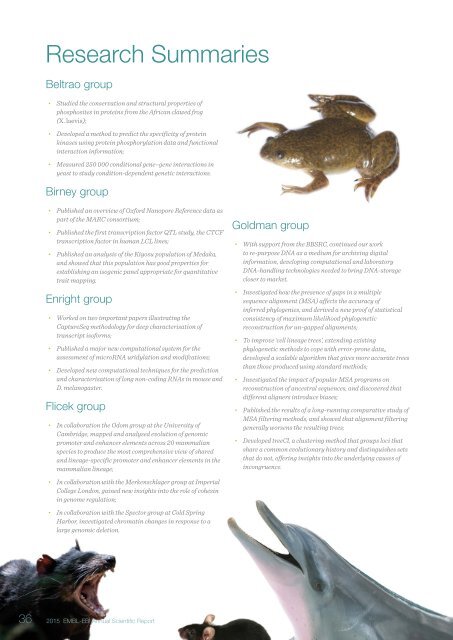Annual Scientific Report 2015
EMBL_EBI_ASR_2015_DigitalEdition
EMBL_EBI_ASR_2015_DigitalEdition
Create successful ePaper yourself
Turn your PDF publications into a flip-book with our unique Google optimized e-Paper software.
Research Summaries<br />
Beltrao group<br />
• Studied the conservation and structural properties of<br />
phosphosites in proteins from the African clawed frog<br />
(X. laevis);<br />
• Developed a method to predict the specificity of protein<br />
kinases using protein phosphorylation data and functional<br />
interaction information;<br />
• Measured 250 000 conditional gene–gene interactions in<br />
yeast to study condition-dependent genetic interactions.<br />
Birney group<br />
• Published an overview of Oxford Nanopore Reference data as<br />
part of the MARC consortium;<br />
• Published the first transcription factor QTL study, the CTCF<br />
transcription factor in human LCL lines;<br />
• Published an analysis of the Kiyosu population of Medaka,<br />
and showed that this population has good properties for<br />
establishing an isogenic panel appropriate for quantitative<br />
trait mapping.<br />
Enright group<br />
• Worked on two important papers illustrating the<br />
CaptureSeq methodology for deep characterisation of<br />
transcript isoforms;<br />
• Published a major new computational system for the<br />
assessment of microRNA uridylation and modifcations;<br />
• Developed new computational techniques for the prediction<br />
and characterisation of long non-coding RNAs in mouse and<br />
D. melanogaster.<br />
Flicek group<br />
• In collaboration the Odom group at the University of<br />
Cambridge, mapped and analysed evolution of genomic<br />
promoter and enhancer elements across 20 mammalian<br />
species to produce the most comprehensive view of shared<br />
and lineage-specific promoter and enhancer elements in the<br />
mammalian lineage;<br />
• In collaboration with the Merkenschlager group at Imperial<br />
College London, gained new insights into the role of cohesin<br />
in genome regulation;<br />
• In collaboration with the Spector group at Cold Spring<br />
Harbor, investigated chromatin changes in response to a<br />
large genomic deletion.<br />
Goldman group<br />
• With support from the BBSRC, continued our work<br />
to re-purpose DNA as a medium for archiving digital<br />
information, developing computational and laboratory<br />
DNA-handling technologies needed to bring DNA-storage<br />
closer to market.<br />
• Investigated how the presence of gaps in a multiple<br />
sequence alignment (MSA) affects the accuracy of<br />
inferred phylogenies, and derived a new proof of statistical<br />
consistency of maximum likelihood phylogenetic<br />
reconstruction for un-gapped alignments;<br />
• To improve ‘cell lineage trees’, extending existing<br />
phylogenetic methods to cope with error-prone data,,<br />
developed a scalable algorithm that gives more accurate trees<br />
than those produced using standard methods;<br />
• Investigated the impact of popular MSA programs on<br />
reconstruction of ancestral sequences, and discovered that<br />
different aligners introduce biases;<br />
• Published the results of a long-running comparative study of<br />
MSA filtering methods, and showed that alignment filtering<br />
generally worsens the resulting trees;<br />
• Developed treeCl, a clustering method that groups loci that<br />
share a common evolutionary history and distinguishes sets<br />
that do not, offering insights into the underlying causes of<br />
incongruence.<br />
36<br />
<strong>2015</strong> EMBL-EBI <strong>Annual</strong> <strong>Scientific</strong> <strong>Report</strong>


